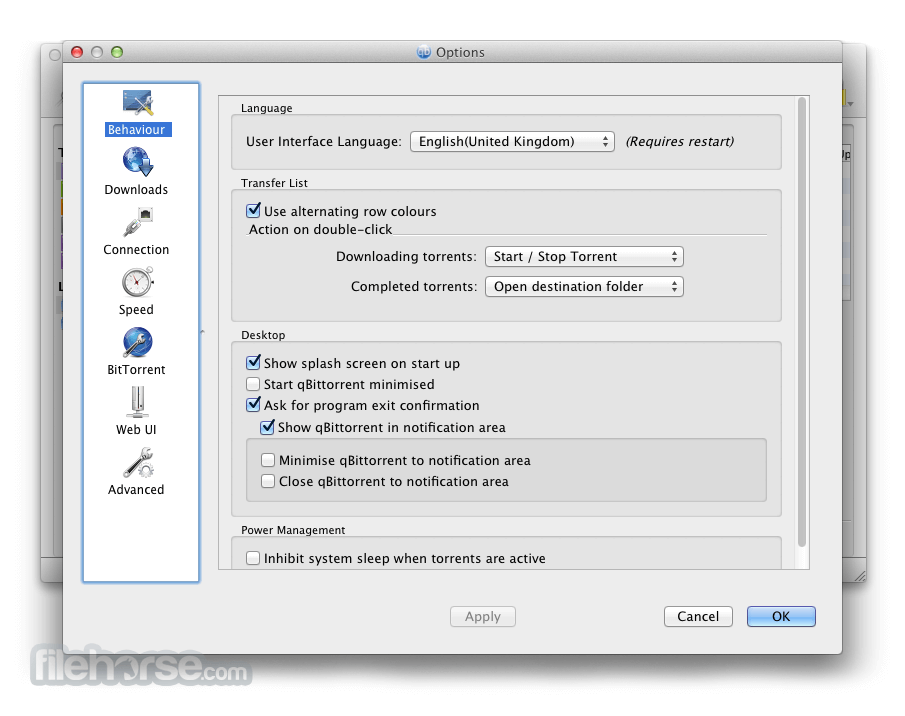

- #Qbittorrent web ui how to
- #Qbittorrent web ui install
- #Qbittorrent web ui password
- #Qbittorrent web ui series
#Qbittorrent web ui how to
We will also show you how to enable the clients’ web interface. This section will show you how to open the qBittorrent interface on your Ubuntu device. Once the web interface version of qBittorrent has finished installing, proceed to the “Configuring qBittorrent Nox using the Terminal” section.
#Qbittorrent web ui install
To install qBittorrent-nox to your Ubuntu device, use the following command in the terminal. This torrent client is available as a separate package for those who don’t want or need the desktop interface.ġ. The web interface only version of qBittorrent goes by the name “ qBittorrent-nox“. Installing the Web Interface Only version of qBittorrent After the install process has been completed, you can skip to “ Setting Up qBittorrent Desktop on Ubuntu“. This will install the torrent client using the apt package manager. We can install this version by running the following command on your device. With this section, we will be installing the desktop client of qBittorrent to our Raspberry Pi.ġ. Installing the Desktop qBittorrent Client You can still use the web interface of qBittorrent on Ubuntu when using the desktop interface. With the official package repository added, we can now install the qBittorrent client on your Ubuntu system.īefore continuing, you need to decide whether you want to use the desktop or web interface.
#Qbittorrent web ui series
Packages for the stable series of qBittorrent How to Install qBittorrent on Ubuntu The “ Description:” should read something like what we have shown below. When prompted, you will need to press the ENTER key to confirm the addition of the new repository. sudo add-apt-repository ppa:qbittorrent-team/qbittorrent-stableĢ. Running the command below will add the official qBittorrent repository to the Ubuntu device. For this section, we only have a single step, and this step only requires us to run a single command. First, if you are using the desktop flavor of Ubuntu, you can open the terminal by pressing CTRL + ALT + T.ġ. This is a simple process that we will complete in a couple of steps. Typically the version that is made available through Ubuntu’s repository is out of date. Adding this repository will allow us to install the latest version of this torrent client. Preparing your Ubuntu System for qBittorrentīefore we proceed, let us add the official package repository for qBittorrent to our Ubuntu system.
#Qbittorrent web ui password

Setting Up qBittorrent Desktop on Ubuntu.Installing the Web Interface Only Version.Installing the Desktop qBittorrent Client.Preparing your Ubuntu System for qBittorrent.The initial configuration and installation steps will require you to utilize your Ubuntu systems terminal. In this tutorial, you will install the latest version of qBittorrent to your Ubuntu system by utilizing the team’s PPA. One of its best features is its web interface that allows you to manage almost all aspects of the torrent client remotely.īest of all, qBittorrent supports all current versions of Ubuntu. This client has many features that you will find very useful quickly. It is fast, open-source, and lightweight, making it one of the best clients you can use on Ubuntu. QBittorrent is a popular torrent client and is considered one of the best alternatives to BitTorrent. I got a blank webpage using the chrome browser.In this tutorial, we will be showing you how to install the qBittorrent client on Ubuntu. Ssl_certificate_key /etc/ssl/certs/ ĬONTAINER ID IMAGE COMMAND CREATED STATUS PORTS NAMESĨe7b4c80c1ea linuxserver/qbittorrent "/init" 3 hours ago Up 3 hours 0.0.0.0:6881->6881/tcp, 0.0.0.0:6881->6881/udp, 8080/tcp, 0.0.0.0:44373->8073/tcp qbittorrentīut I could not get visit the webUI: curl localhost:6881

Here was the docker-compose.yml: cat docker-compose.ymlĪnd nf: cat was the nginx config file: cat. Nextcloud docker was done in the same way, and It worked for me. I made a forwarding on my router then a reverse proxy using nginx And finally, docker ports mapping.


 0 kommentar(er)
0 kommentar(er)
